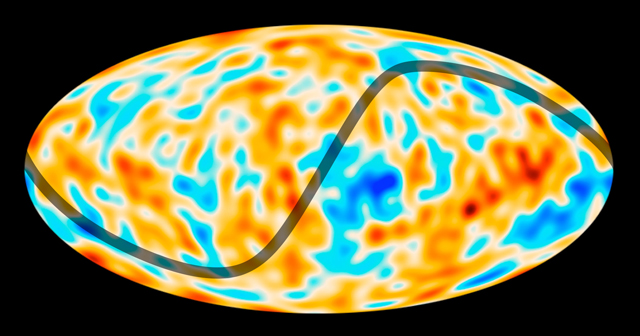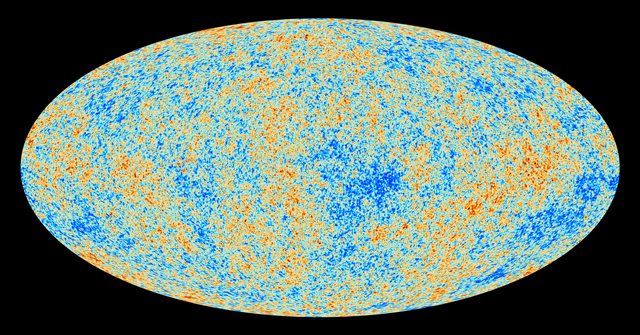On the asymmetric map of space visible traces of its origin

The image of the early Universe obtained from the Planck telescope shows a strange pattern: temperature fluctuations in the part of the sky to the right of the gray line are stronger than in its part on the left side of the line
If our universe had crashed into the next one at the moment of its sharp growth in the first second of existence, then such a collision would leave a mark. And Matthew Kleban believes that he is observing just such a trace in the most detailed of the existing images of the dawn of the Universe. The satellite image confirms the conclusion made from the previous photo: one half of the young cosmos was more coarse-grained than the other.
')
Since there is little other information about what happened during the first moments of the Universe, Kleban, together with dozens of cosmological theorists, is trying to put together a history of the origin of space based on a new granular hint.

Matthew Kleban, Adjunct Professor of Physics at New York University and graduate student Marjorie Shillo discuss the clash of two universes bubbles
“When they crashed into each other, a shock wave spread across our universe,” said Kleban. Such a wave — if it is just a snapshot of it — would serve as proof of the hypothesis of the multiverse, the well-known, but unproved idea that our Universe is just one of an infinite number of universes arising in an immense vacuum.
Most cosmologists believe that this footprint may be false.
"This is a game with high stakes," said Mark Kamionkowski , a professor of physics and astronomy at the University. Johns Hopkins, who proposed several new models of the Big Bang, which explained the asymmetry between the two halves of space. "We would like to know more about the origin of the Universe, but nature does not give us too many clues." Asymmetry "may turn out to be a statistical deviation," says Kamionkowski, "or it can only be the tip of the iceberg."
Everyone will judge the time or tricky tests.
The asymmetry of our Universe can be traced in the relic radiation - the afterglow left from the moment when the Universe became transparent 380 000 years after the Big Bang. The mist of charged particles, which until then filled the space, cooled enough to coagulate into neutral atoms, and released the light, which for the first time could travel unhindered. Over the past few years, the European Space Agency’s Planck satellite collected a 50-megapixel image of this light coming from all directions, and each photon received recorded the temperature from which it was emitted 13 billion years ago.

Cosmologists believe that the quantum fluctuations of the times of the Big Bang stretched out during exponential growth, known as inflation, and turned into hot and cold places that served as seeds of galaxies and voids.
Relic radiation indicates that the temperature in the 380,000-year-old Universe was almost uniform, and deviated from the average by only 1 part out of 100,000. Relatively cold and hot areas — the seeds of future galaxies and voids — are believed to have evolved from quantum fluctuations, random bursts of energy, amplified during exponential growth in the first moment of existence of the universe, known as inflation.
Cosmologists want to trace this process back to the reason for its occurrence.
In the absence of ideas about how physics works in an extremely hot and compressed state that existed in the newborn Universe, physicists use the “toy model” of the event: the inflation field, which fills the entire space, turned into an unstable state approximately 10 -36 seconds after the Big Bang, which led to space swelling of 10 78 times, after which the inflationary field stabilized again after 10 -30 s. According to this model, the space had to stretch out evenly, and turn into a uniformly random spotted distribution of hot and cold regions in relic radiation. But the data refute this opinion.
“On the one hand, hot and cold areas are hotter and colder than on the other,” explains Kamionkowski.
The Wilkinson Microwave Anisotropy Probe , or WMAP spacecraft, first discovered evidence that fluctuations in one half of the CMB are stronger than in the other half, in 2007. But then it could be attributed to measurement error. The Planck map strengthened this evidence and showed the fluctuations in greater detail, which allowed physicists to reject several explanations and come up with several others.
The asymmetry of temperature fluctuations of the Universe, as well as the topographic difference in the territories of the USA, is best seen on the largest scales. A square meter of land in Colorado is not much more hilly than a square meter in Indiana, but as you increase the mountains and valleys of Colorado become much more visible. "One part of the sky can be thought of as Indiana, and the other as Colorado," says Donghyu Jong, Ph.D. from the Kamionkowski group. - These fluctuations are very strange. It’s hard to imagine why they originated. ”
Some cosmologists believe that this is a statistical deviation. The chances that such an asymmetry could happen by chance at the birth of the Universe are in the range from 0.1% to 1% - approximately the same as the chances of a coin being thrown to be tipped eight times in a row.
“If I put money on this, I would put on a fluctuation,” said Sean Carroll , a cosmologist at the California Institute of Technology. - But the point is that we are not playing for money. If this information tells us something about the early universe, it can be extremely important. "
Cosmologists have already put forward several competing theories explaining how events during and immediately after the Big Bang could create this asymmetry.
Few people believe that the toy model, in which the inflation field suddenly appeared, can fully explain what gave rise to the universe. This field may turn out to be one of the additional convoluted dimensions of space, about which the hypothetical “theory of everything” tells us, string theory, in which, most likely, there should be several inflation fields. In his work on arXiv.org, John MacDonald , a cosmologist from Lancaster University in Britain, showed that the two-field model can explain the asymmetry of the background radiation if the second, curvaton field, disintegrated at the end of inflation and after the formation of dark matter.
As another explanation given in an article for the journal Physical Review D, Kamionkowski and his colleagues calculated that asymmetry could arise from variations in certain cosmological parameters in different places of the Universe. One of the most probable models, in which a 6% change in a parameter from one end of the universe to the other is described, “is in quite good agreement with observations,” said Kamionkowski. The parameter can be tied to various defects of space-time, which, according to some theories, could become catalysts of inflation.

Or, as Kleban and his colleagues show in an article published in Physical Review D , and in their next work, asymmetry could appear as a result of a sharp collision between two universes or two points of our Universe. In the multiverse hypothesis, bubbles often have to occur close to each other and collide. Also, bubbles are able to collide with themselves during expansion around some twisted spatial dimension (you can imagine a circle growing on the surface of a cylinder). Such a collision could trigger inflation.
If the shock wave from such a collision can be seen in relic radiation, this will be clear evidence in favor of the multiverse theory, says Kleban. But, most likely, the edge of the shock wave disappeared behind the horizon of the observable part of the Universe, leaving behind it, like a ship passing by, light turbulence. Stretched remnants of such a trace can be depicted on the Planck map.
These residues "will affect the largest structures we see," Kleban said. They were supposed to grow in size with the expansion of the universe, which should have had an effect similar to the topographic differences between Colorado and Indiana.
Since each of the following inflation models gives out their predictions about the direction of polarization of the ancient light, the new “polarization map” of the CMB will help to choose the correct hypothesis. So far, theorists need to adjust their Big Bang theories to the available data. “There will always be unprovable things because of the lack of necessary technologies,” said Kleban. “You just have to try and try your best.”
Source: https://habr.com/ru/post/401633/
All Articles